- Mineral Fusion Nail Polish Remover Review: Is It a Good Acetone Alternative? - November 23, 2022
- How to Find the Best Nail Polish Remover: Plus 3 Acetone Myths - May 25, 2022
- 23 Clear Nails Inspiration and Ideas: From Elegant to Edgy - May 25, 2022
Artificial nails and gel nails are not harmful but can become harmful to your natural nails if done, cared for, or removed improperly. Once your natural nail is damaged from improper nail removal, there is no getting back to healthy nails until the nail has completely grown out, taking three to six months. To save you from all of this hassle, I’ll take you through, step by step, how to remove nails and what not to do below.
How to Remove Nails Up Front
- Gently trim down and file the surface of the nail.
- Soak cotton balls in acetone.
- Place the cotton balls and wrap them in foil.
- Wait 15 to 20 minutes and scrape off the nail with a cuticle pusher.
- Finish by buffing the natural nail and applying cuticle oil.
What Not to Do
Incorrectly removing artificial nails or gel nails can damage your natural nails beyond repair. Anything from light layering of the natural nail coming with removal to permanently damaging your nail bed could happen. Before we hop into how to remove nails properly, let us go over what not to do to drive it home for you.
Rip Them Off
Ripping artificial nails or gel nails off is a big no, no, and probably one of the most common causes of nail damage with artificial and gel nails. When you rip off gel polish, it will most likely take layers of your natural nail, leaving an uneven, thin natural nail. Ripping off acrylics or dip powder nails can permanently damage your nail bed by lifting your nail or taking your entire natural nail.
Bite Them Off
Biting off artificial nails is even worse than biting your natural nails because fake nails don’t come off in layers as your natural nail does. They crack and split when you bite them, and since they are attached to your natural nail, this can cause your natural nail to crack and split. If you want your artificial nails shorter, use a nail file to file them down rather than biting them.
File Them Off
Filing your artificial or gel nails down a bit before removal can help speed up the process. However, removing your fake nails by only sanding them down can cause your natural nail to become uneven and thin. Do not attempt to file acrylic or gel nails off because you will never be able to file them evenly, and it will end up with you ultimately filing your natural nail down.
Tools Needed for Removal
*Do not attempt to use a nail drill instead of a file without proper education.
- 100% Acetone
- Cotton Balls
- Aluminum Foil
- Coarse and Fine Nail Files
- Cuticle Pusher or Orangewood Stick
- Cuticle Oil
How to Remove Acrylic and Dip Powder
Although acrylics and dip powder are made of different components and applied differently, they are removed in the same manner. Dip powder is a newer, updated version of acrylics that is lightweight and adheres to the nail better, so it may be more challenging to remove. In comparison, acrylics are the traditional way of doing an artificial nail, and you can find this method at almost any nail salon.
Gently Trim and File the Surface
Before doing anything, trim down your nails to your desired length with nail clippers. This will give you less nail to remove, and it may even help the artificial nail lift easier because there is no longer a sealed barrier at the ends. You will have to reshape and buff your nails after removing them, so don’t worry about trimming them perfectly.
Then, take a coarse nail file and file down the surface of the acrylics until they are all matte and rough. Make sure you do not file your nails down to the point where you see your natural nail because you could start filing your natural nail, making your nails thinner. This process will help the acetone soak to make the soaking time quicker.
Soak Cotton Balls in Acetone
Fill a small bowl with 100% acetone. Make sure your acetone is pure acetone and not mixed with other nail polish removing ingredients because those products do not work as well. Rip five cotton balls in half to make ten cotton pieces and drop them in the bowl of acetone. Leave the cotton pieces soaking during the next step.
Place and Wrap in Foil
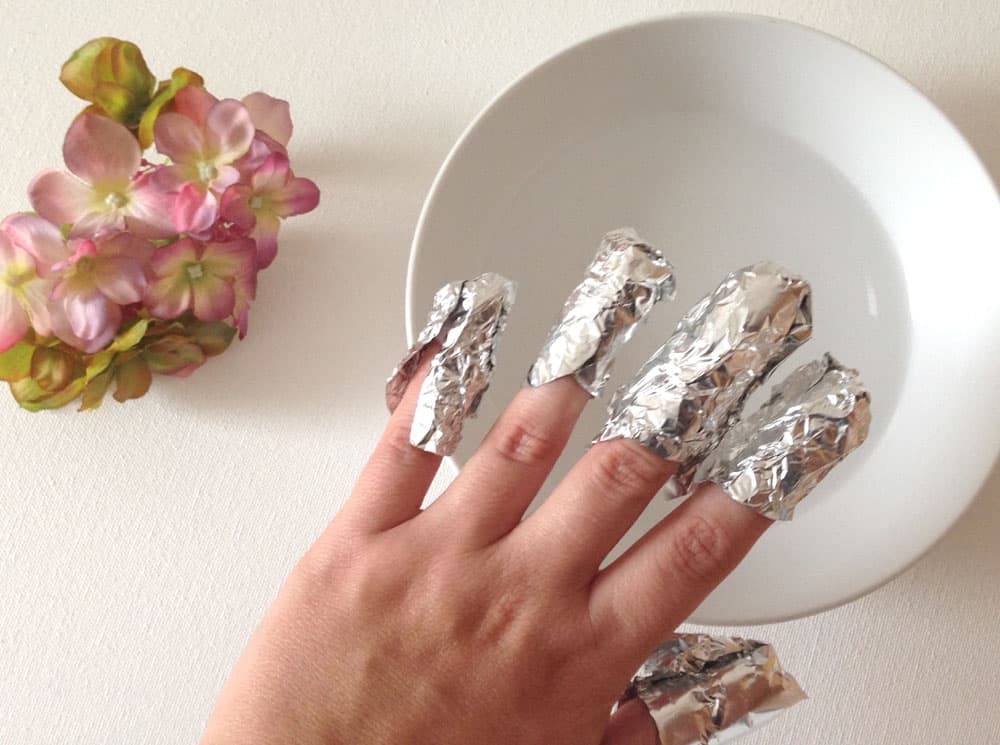
Cut or tear foil into squares about three inches long by 3 inches wide. Pick up a cotton piece from the acetone with tweezers or your fingers and place it centered on your nail. Take one of your foil squares and wrap it around the acetone-soaked cotton and your finger to keep the cotton from moving. Leave these on your fingers for 20 to 30 minutes.
You may need a friend to help you with the second hand because your first hand will be covered entirely in foils, but it is possible to do it yourself. Another tip is to do your three outer fingers first on each hand, leaving your pointer and thumb for last to cover most of the nails before having to struggle with foil-covered fingers. If your cotton becomes dry before your nails start lifting, you may redo this process.
Scrape Off Acrylic or Dip Powder
Check your nails after 20 minutes and see if the edges of your artificial nails look like they are lifting. If they are not raising, reapply the acetone-soaked cotton and sit for another 10 minutes. Once your artificial nails look like they are raising, remove the foil wraps and use a cuticle pusher or orangewood stick to scrape the fake nail off.
Make sure you are scraping from the base of the nail to the tip, or else you could accidentally scrape off layers of your natural nail. The acrylic or dip powder should come off somewhat easily without much effort. If certain parts of the nail are resistant to removal, repeat the soaking step for another 10 to 15 minutes.
How to Remove Gel Polish Nails
This is how to remove the soak-off gel polish nails that people typically think of when you say gel nails and not the hard gel nails listed below. Soak-off gel polish is like regular nail polish, but it is cured under a UV lamp and lasts much longer. If removed improperly, gel polish can take off layers of your natural nail with it, thinning out your natural nail.
Soak Cotton Balls in Acetone
Take five cotton balls, rip them in half to make ten cotton pieces for each nail, and fill a small bowl with 100% acetone. You can use a milder nail polish remover, but it will take longer for the nail polish to soak off. Leave to cotton pieces soaking in the bowl as you remove each piece for the next step.
Place and Wrap in Foil
Tear aluminum foil into ten three-inch by three-inch squares. Take a cotton piece out of the bowl of acetone and place it on top of the nail. Make sure to squeeze it softly so it’s not dripping, but you want the cotton to be pretty saturated. Wrap a piece of foil around the acetone-soaked cotton and your finger and sit for ten to fifteen minutes.
You may want to do your three outer fingers on both hands first, leaving your pointer finger and thumb last. This will make it easier because you only have to wrap two fingers with foil-wrapped fingers rather than a whole hand. You could also have a friend help you cover your second hand.
Scrape Off Gel Polish
If acetone is left on your nails long enough, the entire gel polish will come off the nail with the foil wrapping. However, sometimes gel polish can be stubborn and needs a little help coming off the nail. In this case, use a cuticle pusher or orangewood stick to scrape off the remaining gel polish.
Before scraping off the gel polish, it needs to be slightly lifted on the edges at least. If it is not raising, go back and resoak them for another five minutes. You should also scrape from the base of the nail toward to tip, so you do not scrape off any layers of your natural nail.
How to Remove Hard Gel Nails
Hard gel is another artificial nail material that can create length and strength, along with color and design. This method of doing artificial nails was introduced in the 80s and was only popular for ten to fifteen years. Some nail technicians still use this method of creating fake nails, but it is rare.
See a Technician
You can only remove hard gel nails by filling them with a nail drill. As I’ve stated above, you should not try to remove your nails with a nail drill because this can be dangerous if you are not adequately trained in how to do so. If you file them down too much, your nails could become so thin that it is not healthy, and you can file a hole into your nail with a nail drill.
Please, see an experienced nail technician to remove hard gel nails.
How to Remove Glue on Nails
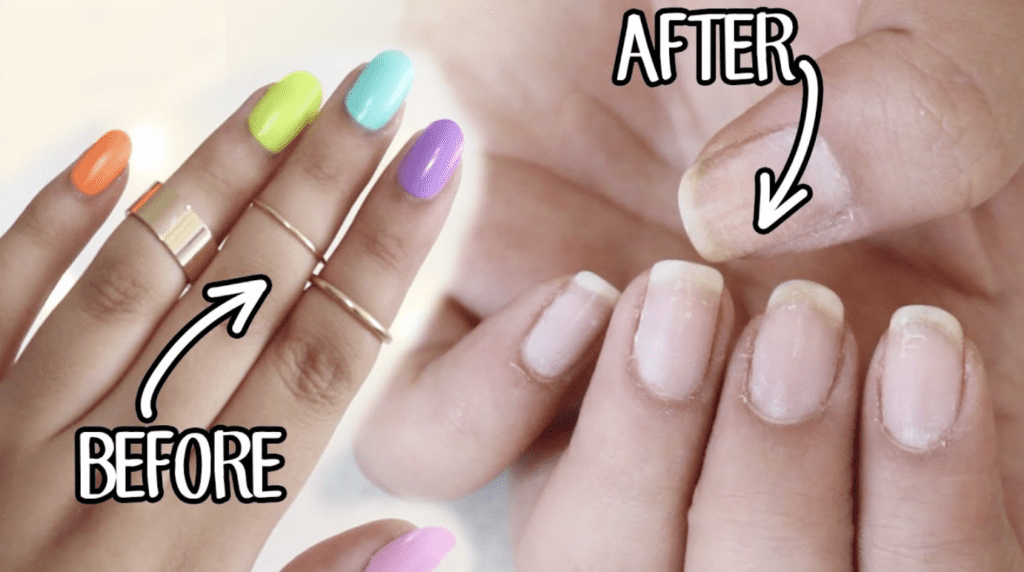
Glue on fake nails has been making a comeback lately, and they are made more realistic now than ever before. They can last up to a week, be fixed instantly if you accidentally pop a fake nail off, and are a cheap way to give yourself long, beautiful nails. Even though they are so easy to pop off with the flick of a finger, you should not do this because the glue can take layers of your natural nail with it.
Fill a Bowl with Acetone
You will want to use a glass or ceramic bowl to fit both of your hands’ fingertips inside. Fill the bowl with just enough acetone to submerge your nails. You can also use acetone-free nail polish removers or hot water with a couple of dots of dish soap, but it will take much longer to soak off.
Soak Your Fingertips
Put your fingers into the bowl of acetone, making sure that all of your nails are entirely submerged. Let them sit and soak according to the list below:
- Five minutes if you are using acetone
- Ten minutes if you are using the acetone-free remover
- Twenty minutes if you are using hot water.
Gently Pop Them Off
If your fake nails have not already fallen off inside the bowl of acetone, they should easily pop off without prying. You can use your other nails to get under the base of the fake nail and lift them or use a cuticle pusher to get under the base of the artificial nail. If you are using a cuticle pusher, go into the fake nail from the bottom of the nail and not the tip.
Care After Nail Removal
Your nails will rarely be at their maximum health when you remove artificial nails or gel polish, and your skin may also feel dry and rough after using acetone. However, you can do a few things to get your nails and fingers back to their natural health and beauty.
Buff the Nail
Your nails will not feel the smoothest after removing your artificial nails or gel polish. Take a fine file or nail buffer and lightly buff the top of your nails. You can use a buffer with multiple different grits, like Tropical Shine 4-Way Buffer, to remove ridges and finish your nails with a shine.
Use Cuticle Oil
Cuticle oil is a godsend for dry, unhealthy nails. Your nail grows out of your cuticle, so anything you put on your cuticle will also go into your nail. Most cuticle oils have vitamins that help build strong, healthy nails, and they keep your nails and cuticle moisturized.
Moisturize Your Hands
Keeping your hands moisturized ensures that no moisture is removed from your cuticles and nails. You should especially moisturize your hands after soaking your fingers in acetone because it can be extremely drying. For at least a couple of days after using acetone, you want to use a thick hand cream that is highly moisturizing.
Products I Recommend and Love
Nailite Nail Polish Remover
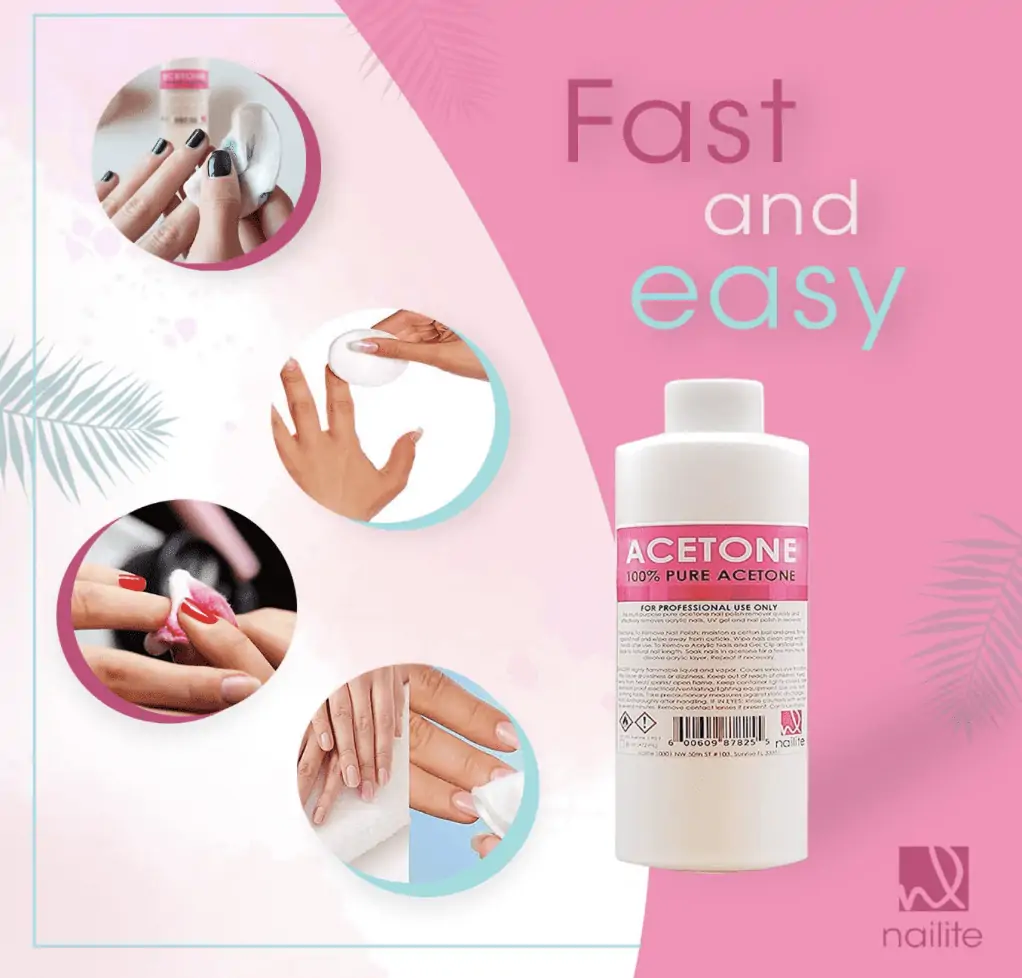
Pros
- 100% pure acetone
- Professional brand
- Made in the U.S.A
Cons
- You need to be extra careful with acetone
Nailite is a brand you may see in your local nail salon, and they make other professional products, such as acrylic. This nail polish remover is 100% pure acetone, meaning it works the fastest when removing artificial nails or gel nails. Other polish removers may say they’re acetone but put hand softening ingredients in the mixture, making the product not work as quickly.
Acetone is a relatively potent chemical, so you have to be extremely careful not to spill it. This nail polish remover will also sometimes remove your furniture’s finish and even fabric coloring. You should also keep it away from children and pets like with household cleaners.
OPI Nail Polish Remover
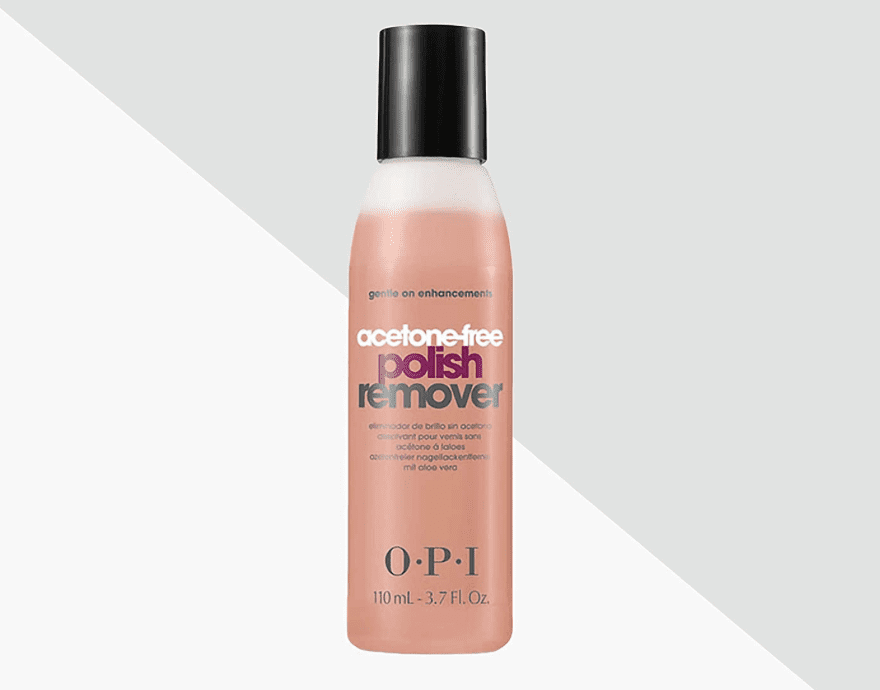
Pros
- Acetone-free
- Can remove nail polish from acrylic nails
- Has aloe for moisture
Cons
- Won’t remove acrylic, dip powder, or gel
- Not the greatest smell
If you are looking for something acetone-free, OPI makes a great nail polish remover that works well for regular polish and glue on nails. This does not mean that it is chemical-free because you always need some kind of acid to remove any polish. However, this nail polish remover is less drying than acetone products and includes aloe for extra moisturizing properties.
With OPI nail polish remover, you can not remove acrylic, dip powder, or gel polish; you can only do that with acetone products. This does make it a great product to use if you want to remove regular polish that was put over acrylics because it will remove the polish but leave the acrylic nail. It also does not smell the greatest because they add fragrance to it, and, in my opinion, adding fragrance to nail polish remover never smells good.
Tweezerman Dual Sided Pushy
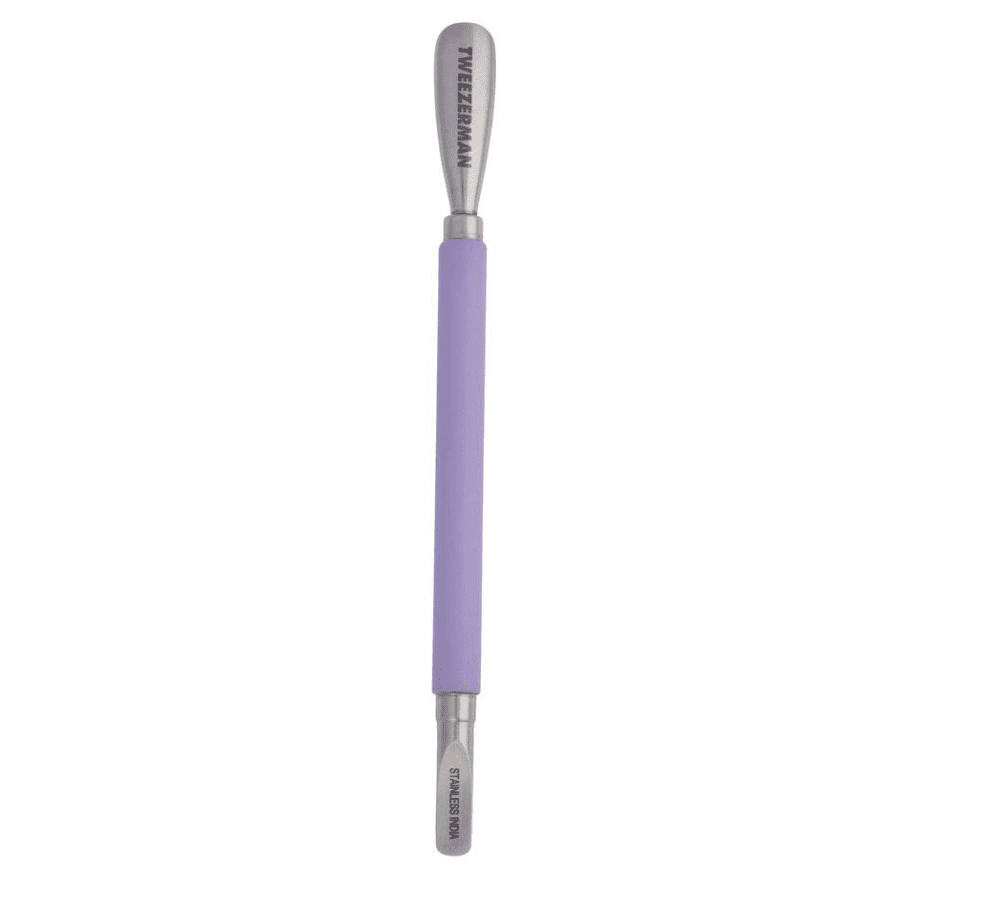
Pros
- Buffed edges
- Contours your natural nail shape
- Made of stainless steel
Cons
- Shorter handle
Tweezerman is a brand that I always go to because I know I’ll get a quality product. Everything is made of stainless steel, which is excellent for nail care because they do not rust and bend as easily when getting wet or thrown around. This cuticle pusher is specifically remarkable because the edges of the pusher are smooth, so it does not scratch your nails. It is also contoured to fit your nail shape, making it easier to remove nails and push back more cuticle areas at once.
My only complaint about this cuticle pusher and most other Tweezerman products is that the handle is shorter than I would like it to be, which can make it more challenging to handle the tool and get proper leverage. The handle can also become slippery when wet, but that’s pretty common with nail tools.
Teenitor Gel Nail File Set
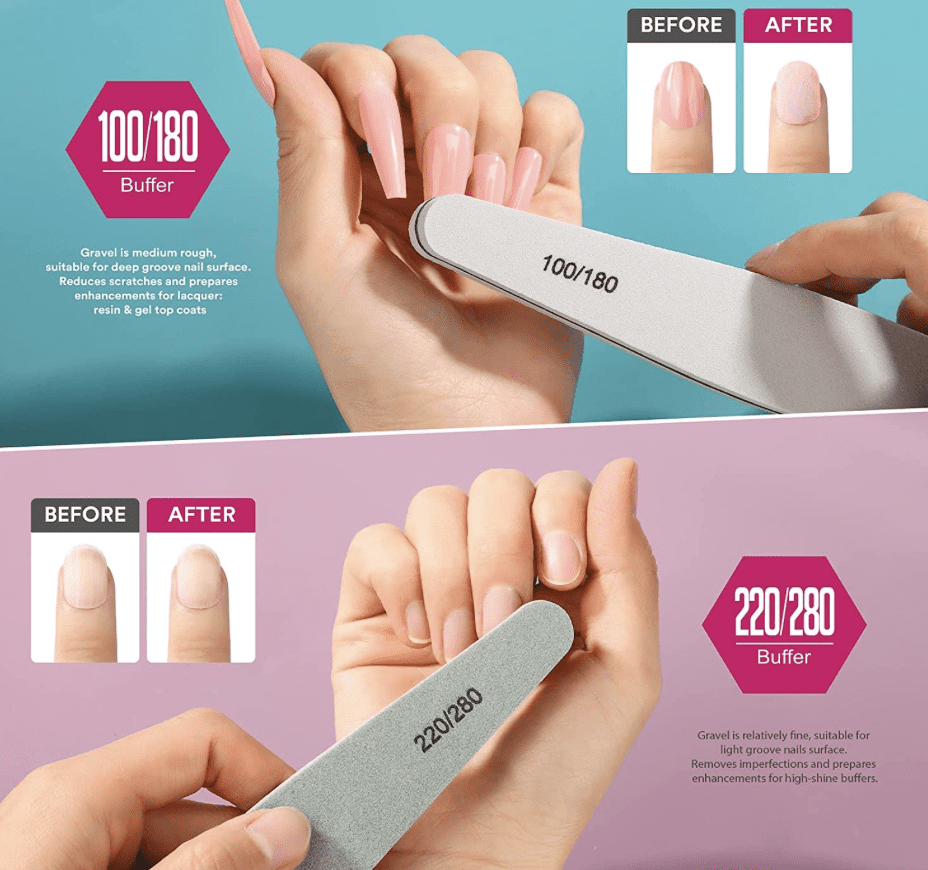
Pros
- It comes with six files
- An assortment of different grits
- Thicker, longer files
Cons
- It has sharp edges at first
The best part about these files is that there is a file for every possible use. The six files come in eight different grits, with some having two sides of varying grit. You can use the 100/180 flex file to file the top of artificial nails and then use the shiner to get your natural nail back to its shiny, natural finish. These files are also in the shape of a long nail file rather than a buffing block, which I think is easier to handle.
Before using these files, you need to file down the edges with an older file or one of the other files in the kit. These files’ edges are sharp right out of the package, and they can give you a small cut around the nail while filing. This is not a huge deal, and you need to file perpendicularly to the edges until they are buffed down smoothly.
Tropical Shine 4-Way Buffer
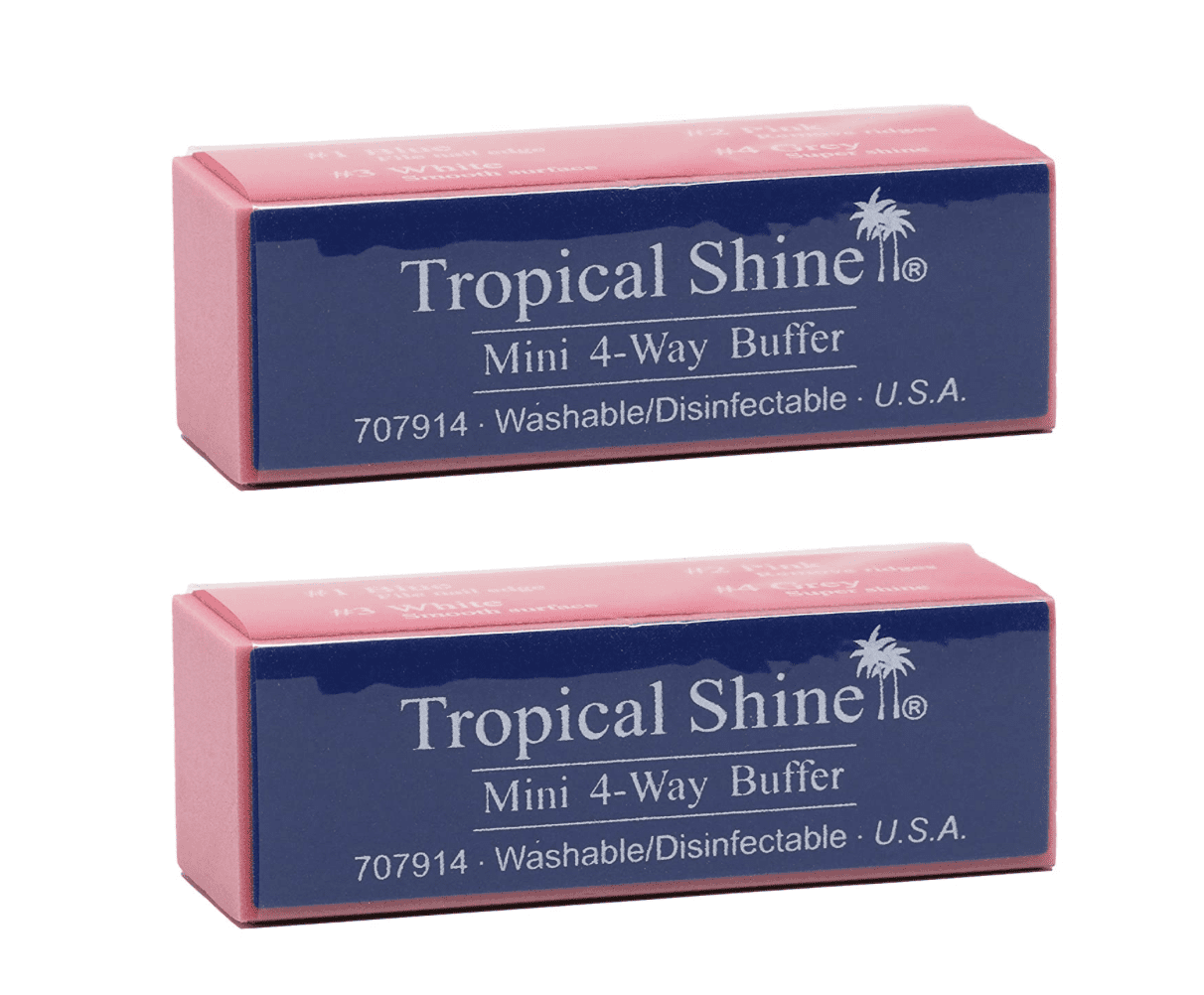
Pros
- Comes with two
- Four sides with different grits
- Long-lasting
Cons
- No really coarse file
This set of two buffers is four different file grits in one. One side is for filing the free edge, one for buffing to remove ridges, one for smoothing, and one for high shine. The grit on this block can last a long time, and you won’t see the grit falling off like you do when using some other files.
Even though the Tropical Shine Buffer comes with four different grit files, there isn’t a coarse side for artificial nails. This buffer is best used on natural nails and not to file down the top of acrylics or dip powder nails. You will need to purchase a separate coarse file for artificial nails.
Cuccio Cuticle Revitalizing Oil
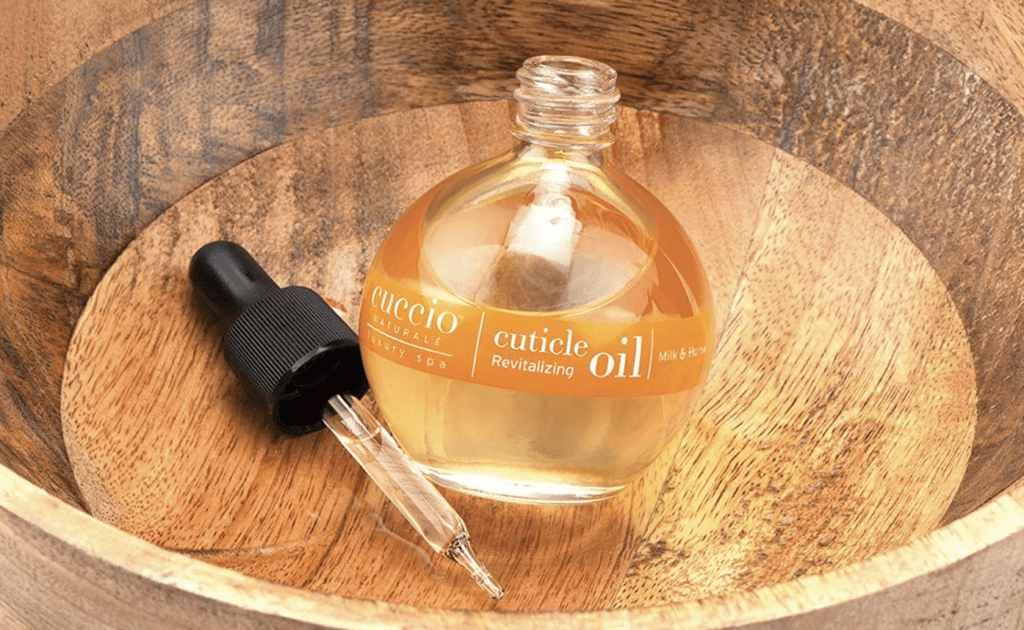
Pros
- Not runny
- It comes in 12 scents, including non-scented
- Has Vitamin E in it
Cons
- It doesn’t absorb well
This is one of my go-to favorites because it is a richer, thicker oil and smells great. It does a magnificent job of moisturizing your nails and cuticles and is long-lasting. Cuccio cuticle oil also has vitamin E derived from safflower oil and sunflower oil, which have antioxidants and can prevent aging and moisture loss.
Although this oil is long-lasting, it does not absorb quickly. Its thicker consistency will not run all over your hands but make it sit on top of your nails for a long time. After applying this oil for at least thirty minutes, you’ll have to be careful with what you touch.
CND Solar Oil
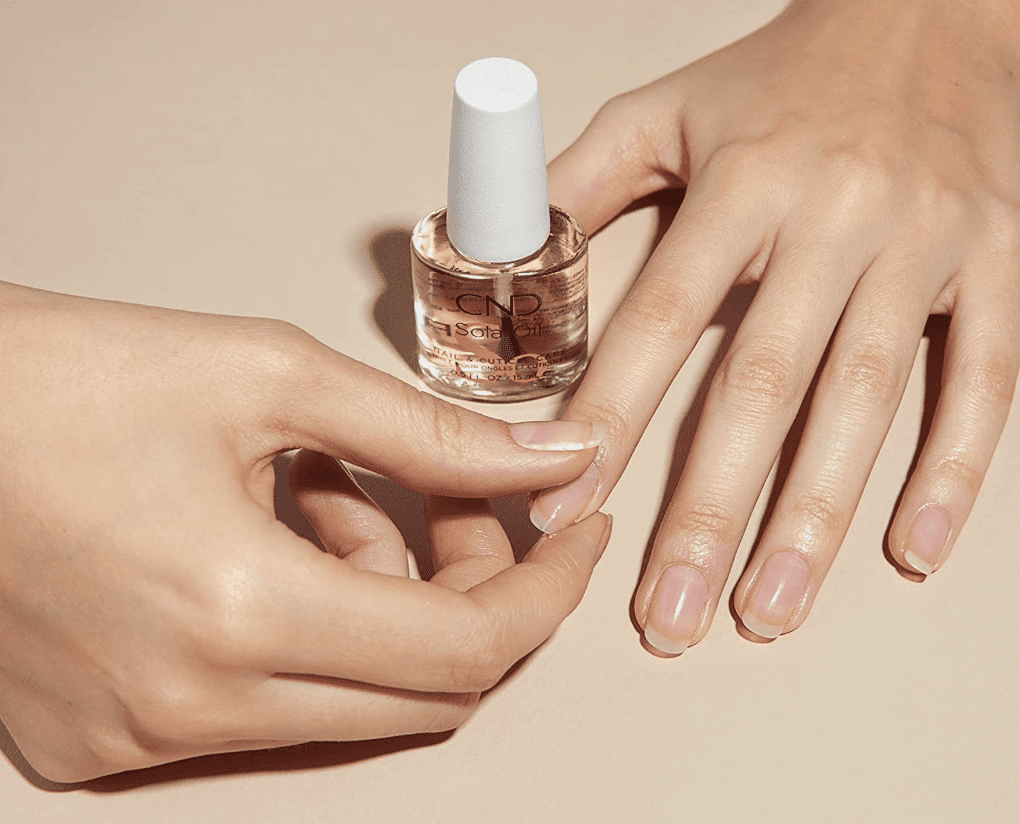
Pros
- Absorbs quickly
- Contains jojoba oil and vitamin E
- Strengthens nails
Cons
- Greasy
CND Solar Oil is what you will see in most nail spas because it works great. It is a thinner consistency and therefore absorbs well and quickly. Containing jojoba oil and vitamin E, this oil is similar to your natural skin’s oil, enhancing what your natural nails are supposed to be.
Even though this oil absorbs quickly, it runs easily until rubbed in. It has more of a greasy feel to it and needs to be massaged into your cuticle and surrounding finger thoroughly. If you rub it in enough, it shouldn’t spread.
O’Keeffe’s Working Hands Hand Cream
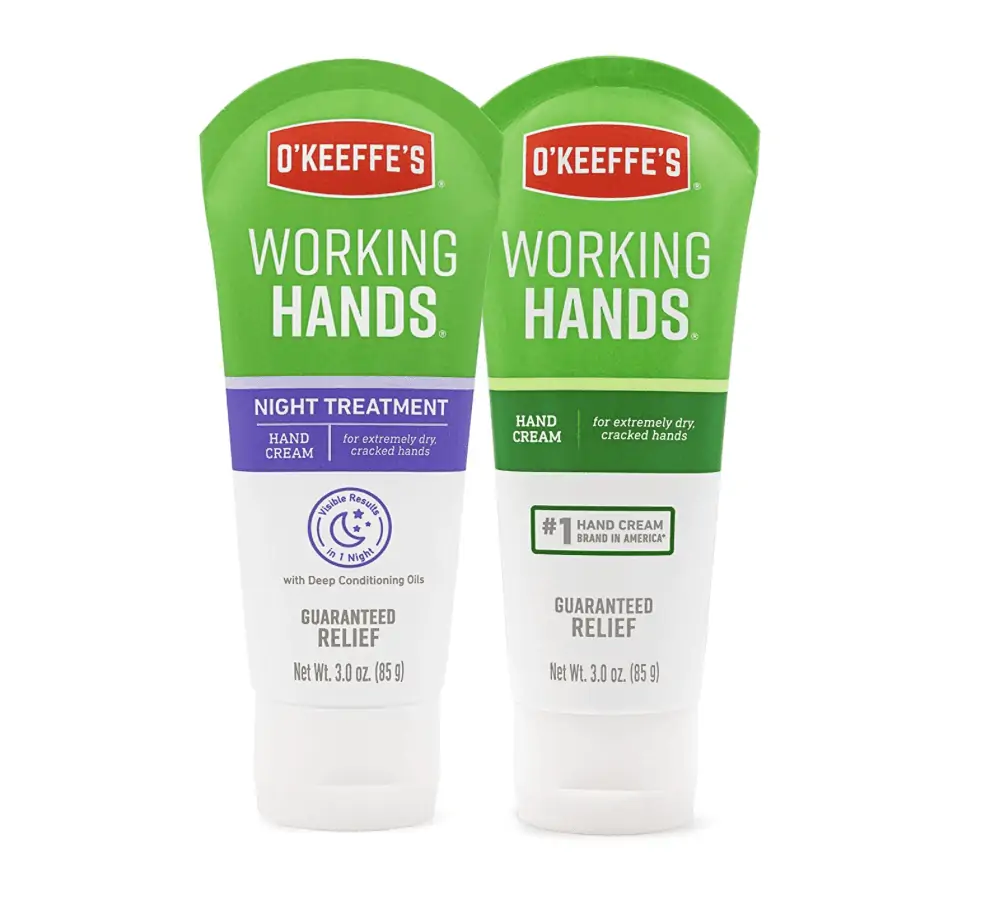
Pros
- For extremely dry and cracked hands
- Heals cracked hands
- It has a day and night cream
Cons
- Contains silicone
This is the hand cream that people go to when their hands feel beyond repair. When your hands are cracking it is most likely due to them being extremely dry, and this hand cream restores them to their healthy selves. It uses penetrating oils and moisturizers while also coating the hand with a protective moisture layer.
The protective layer wors so well because it contains silicone, which is an ingredient that creates a casing over your skin. This does a great job of holding in moisture but keeps things from leaving that are supposed to go through your pores naturally. I will only use this hand cream if your hands are in extreme need of moisture.
Weleda Skin Food
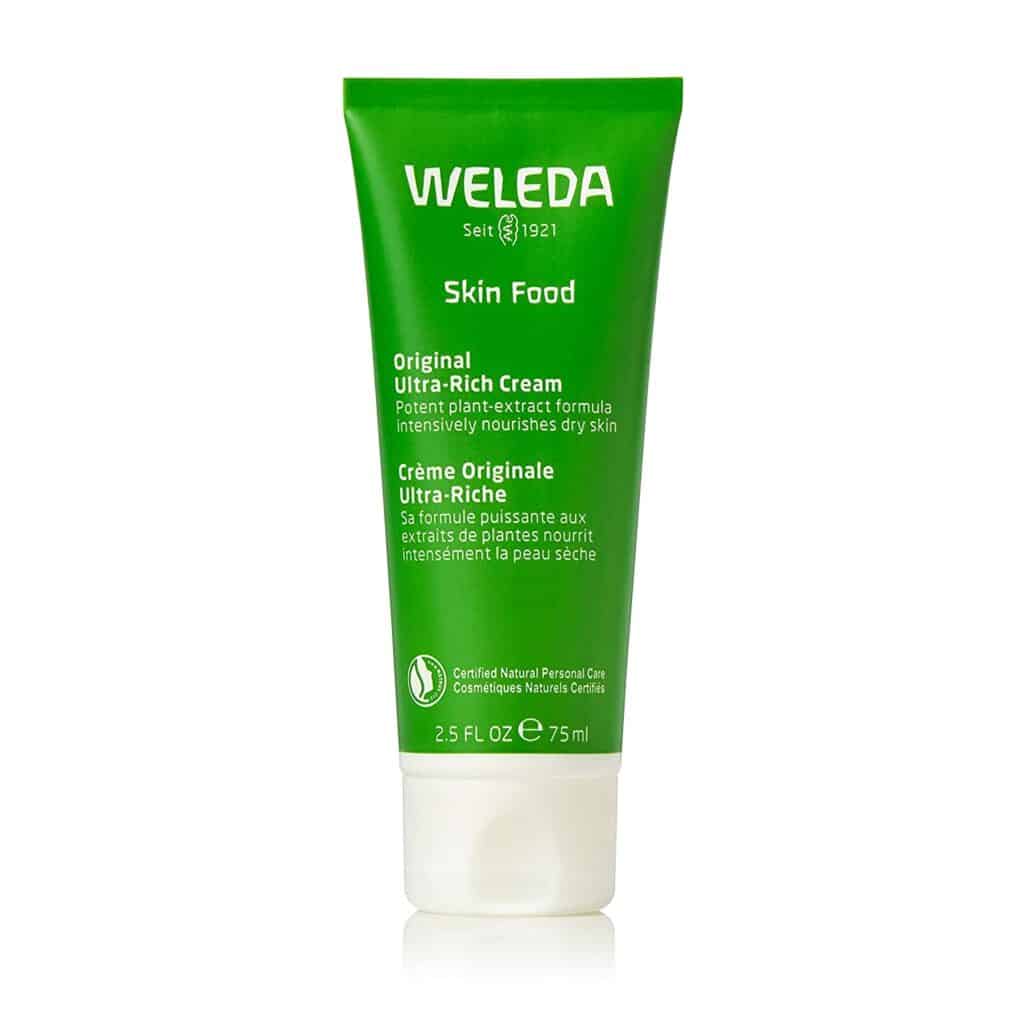
Pros
- Plant-based ingredients
- It contains sunflower seed oil
- Thick, creamy texture
Cons
- Oily
Try Weleda for a more natural hand cream that works well and makes your skin glow. All ingredients in this lotion are plant-based and include sunflower seed oil, which has vitamin E that is the skin’s natural moisturizer and anti-ager. This hand cream is also a thicker texture making it last a long time.
Due to this product being plant-based, it can seem oily. It does leave a layer of slick moisture over your skin, but it creates a layer to keep your natural oils and moisture in. This may not be for you if you don’t like feeling your hand cream after application.
FAQs
Answer: Although they are very similar, acrylic and dip powder is different, and they use different chemicals to adhere to and form the powder. Dip powder is also much lighter, stronger, and sticks to the nail better than standard acrylics.
Answer: Yes, you can! You must be very careful in doing so, though, or else you can damage your natural nail. In this article, you can see how to correctly remove acrylics, dip powder, gel polish, hard gel, and glue on nails without causing any damage to your natural nail.
Answer: There are acetone-free nail polish removers to try to remove your artificial nails. However, these nail polish removers still have chemicals, but they are not as harsh as acetone. It will also take longer to remove your artificial nails with an acetone-free nail polish remover.
Answer: If the proper aftercare is not taken, acetone can harm your nails and surrounding skin. Acetone dries out your skin quickly, so you need to use cuticle oil and a hand moisturizer after using acetone to remove nails. Ensure you are not using acetone on your nails more than every two to three weeks because acetone can make your nails brittle with frequent use.
Answer: Acrylics and gel do not harm your natural nail if applied, cared for, and removed correctly. Any damage you see from acrylics or gel nails is usually due to over filing, nails being ripped off in between manicures, or forcing the nail off. Ensure you visit a reputable nail technician for application, keep your nails moisturized in between manicures, and gently remove your nails.
You Can Remove Nails At Home
Removing your nails at home without damaging your natural nails can be easy, and it just takes some time. Being patient with your acrylic, dip powder, or gel nail removal can affect your nail health. If they were applied correctly and you remove them correctly, you should be back to your beautiful natural nails with the proper aftercare.
